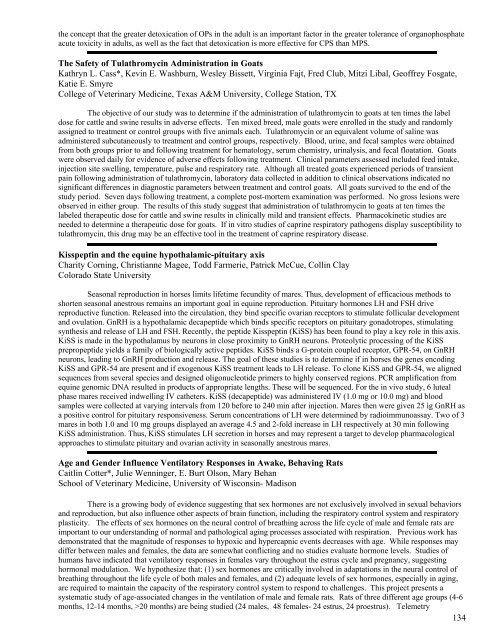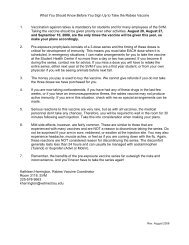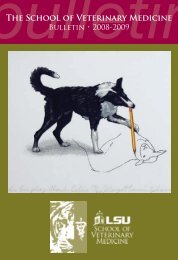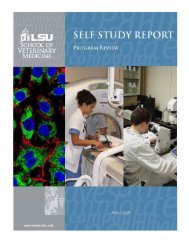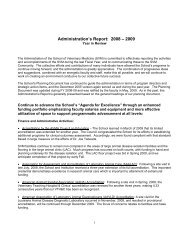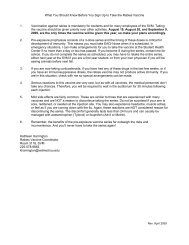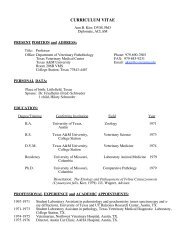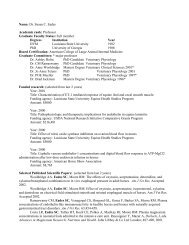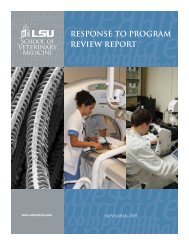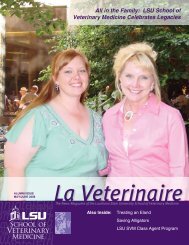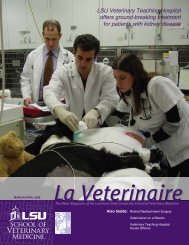the concept that the greater detoxication <strong>of</strong> OPs in the adult is an important factor in the greater tolerance <strong>of</strong> organophosphateacute toxicity in adults, as well as the fact that detoxication is more effective for CPS than MPS.The Safety <strong>of</strong> Tulathromycin Administration in GoatsKathryn L. Cass*, Kevin E. Washburn, Wesley Bissett, Virginia Fajt, Fred Club, Mitzi Libal, Ge<strong>of</strong>frey Fosgate,Katie E. SmyreCollege <strong>of</strong> <strong>Veterinary</strong> <strong>Medicine</strong>, Texas A&M University, College Station, TXThe objective <strong>of</strong> our study was to determine if the administration <strong>of</strong> tulathromycin to goats at ten times the labeldose for cattle and swine results in adverse effects. Ten mixed breed, male goats were enrolled in the study and randomlyassigned to treatment or control groups with five animals each. Tulathromycin or an equivalent volume <strong>of</strong> saline wasadministered subcutaneously to treatment and control groups, respectively. Blood, urine, and fecal samples were obtainedfrom both groups prior to and following treatment for hematology, serum chemistry, urinalysis, and fecal floatation. Goatswere observed daily for evidence <strong>of</strong> adverse effects following treatment. Clinical parameters assessed included feed intake,injection site swelling, temperature, pulse and respiratory rate. Although all treated goats experienced periods <strong>of</strong> transientpain following administration <strong>of</strong> tulathromycin, laboratory data collected in addition to clinical observations indicated nosignificant differences in diagnostic parameters between treatment and control goats. All goats survived to the end <strong>of</strong> thestudy period. Seven days following treatment, a complete post-mortem examination was performed. No gross lesions wereobserved in either group. The results <strong>of</strong> this study suggest that administration <strong>of</strong> tulathromycin to goats at ten times thelabeled therapeutic dose for cattle and swine results in clinically mild and transient effects. Pharmacokinetic studies areneeded to determine a therapeutic dose for goats. If in vitro studies <strong>of</strong> caprine respiratory pathogens display susceptibility totulathromycin, this drug may be an effective tool in the treatment <strong>of</strong> caprine respiratory disease.Kisspeptin and the equine hypothalamic-pituitary axisCharity Corning, Christianne Magee, Todd Farmerie, Patrick McCue, Collin ClayColorado <strong>State</strong> UniversitySeasonal reproduction in horses limits lifetime fecundity <strong>of</strong> mares. Thus, development <strong>of</strong> efficacious methods toshorten seasonal anestrous remains an important goal in equine reproduction. Pituitary hormones LH and FSH drivereproductive function. Released into the circulation, they bind specific ovarian receptors to stimulate follicular developmentand ovulation. GnRH is a hypothalamic decapeptide which binds specific receptors on pituitary gonadotropes, stimulatingsynthesis and release <strong>of</strong> LH and FSH. Recently, the peptide Kisspeptin (KiSS) has been found to play a key role in this axis.KiSS is made in the hypothalamus by neurons in close proximity to GnRH neurons. Proteolytic processing <strong>of</strong> the KiSSprepropeptide yields a family <strong>of</strong> biologically active peptides. KiSS binds a G-protein coupled receptor, GPR-54, on GnRHneurons, leading to GnRH production and release. The goal <strong>of</strong> these studies is to determine if in horses the genes encodingKiSS and GPR-54 are present and if exogenous KiSS treatment leads to LH release. To clone KiSS and GPR-54, we alignedsequences from several species and designed oligonucleotide primers to highly conserved regions. PCR amplification fromequine genomic DNA resulted in products <strong>of</strong> appropriate lengths. These will be sequenced. For the in vivo study, 6 lutealphase mares received indwelling IV catheters. KiSS (decapeptide) was administered IV (1.0 mg or 10.0 mg) and bloodsamples were collected at varying intervals from 120 before to 240 min after injection. Mares then were given 25 ìg GnRH asa positive control for pituitary responsiveness. Serum concentrations <strong>of</strong> LH were determined by radioimmunoassay. Two <strong>of</strong> 3mares in both 1.0 and 10 mg groups displayed an average 4.5 and 2-fold increase in LH respectively at 30 min followingKiSS administration. Thus, KiSS stimulates LH secretion in horses and may represent a target to develop pharmacologicalapproaches to stimulate pituitary and ovarian activity in seasonally anestrous mares.Age and Gender Influence Ventilatory Responses in Awake, Behaving RatsCaitlin Cotter*, Julie Wenninger, E. Burt Olson, Mary Behan<strong>School</strong> <strong>of</strong> <strong>Veterinary</strong> <strong>Medicine</strong>, University <strong>of</strong> Wisconsin- MadisonThere is a growing body <strong>of</strong> evidence suggesting that sex hormones are not exclusively involved in sexual behaviorsand reproduction, but also influence other aspects <strong>of</strong> brain function, including the respiratory control system and respiratoryplasticity. The effects <strong>of</strong> sex hormones on the neural control <strong>of</strong> breathing across the life cycle <strong>of</strong> male and female rats areimportant to our understanding <strong>of</strong> normal and pathological aging processes associated with respiration. Previous work hasdemonstrated that the magnitude <strong>of</strong> responses to hypoxic and hypercapnic events decreases with age. While responses maydiffer between males and females, the data are somewhat conflicting and no studies evaluate hormone levels. Studies <strong>of</strong>humans have indicated that ventilatory responses in females vary throughout the estrus cycle and pregnancy, suggestinghormonal modulation. We hypothesize that: (1) sex hormones are critically involved in adaptations in the neural control <strong>of</strong>breathing throughout the life cycle <strong>of</strong> both males and females, and (2) adequate levels <strong>of</strong> sex hormones, especially in aging,are required to maintain the capacity <strong>of</strong> the respiratory control system to respond to challenges. This project presents asystematic study <strong>of</strong> age-associated changes in the ventilation <strong>of</strong> male and female rats. Rats <strong>of</strong> three different age groups (4-6months, 12-14 months, >20 months) are being studied (24 males, 48 females- 24 estrus, 24 proestrus). Telemetry134
transmitters are implanted to measure temperature, and barometric plethysmography is used to measure ventilation andmetabolic indices during normoxia, hypoxia, and hypercapnia. Blood gas analysis is conducted during each gas exposure.Testosterone, estrogen, and progesterone levels in blood serum are measured with ELISA. The results <strong>of</strong> this study may leadto a better understanding <strong>of</strong> the role <strong>of</strong> sex hormones in age- and gender-related changes in ventilatory control and relatedbreathing disorders.The relative importance <strong>of</strong> ER alpha and ER beta in the constrictor response to arginine vasopressin inaortic coarctation-induced hypertension in female ratsJennifer Crawford*, John Stallone, Minga SellersTexas A&M College <strong>of</strong> <strong>Veterinary</strong> <strong>Medicine</strong> & Biomedical SciencesEstrogen has generally been studied for its cardioprotective effects; however recent studies challenge the view thatestrogen is always beneficial. In recent studies, it was observed that estrogen upregulates the COX-2 pathway, resulting inincreases in thromboxane and other vasoconstrictor prostaglandins such as PGH2. To exert its effects estrogen binds to atleast two known receptors, estrogen receptor alpha (ER-α)and estrogen receptor beta (ER-β). This study will investigate therelative importance <strong>of</strong> ER-α; and ER-β; in the upregulation <strong>of</strong> the constrictor prostanoid pathway in the mesenteric artery andits contribution to the development <strong>of</strong> aortic coarctation-induced hypertension in female rats. Ovariectomized female ratswere treated subcutaneously with ER-α; agonist (PPT) or ER-β; agonist (DPN). Mean arterial pressures were measuredevery other day starting at 2 days post surgery, then rats were sacrificed after 12-14 days treatment. 1.5 mm pieces <strong>of</strong>mesenteric artery were mounted in a Halpern-Mulvany myograph. Each segment was randomly selected for treatment with1) NOS competitive inhibitor (L-NAME; 100µm), 2) inhibitor <strong>of</strong> SR calcium release (Simvastatin; 50µm), 3) thromboxanereceptor inhibitor (SQ 29,548; 60 µm) or 4) vehicle control. The contractile tension produced by each segment was thenmeasured and compared. A better understanding <strong>of</strong> ER-α; and ER-β; in all systems is becoming increasingly important.New research in estrogen related diseases, such as breast cancer suggests ER-α; and ER-β; have different roles andsignificance in disease processes. For example higher ER-α; than ER-β; transcription may be a marker for breast and ovariancancer. Investigating the individual effects <strong>of</strong> the estrogen receptors may lead to more markers, as well as targeted treatmentsfor various estrogen receptor related diseases.Using Transgenic Mice to Facilitate the Characterization <strong>of</strong> Serotonin Cells in the Murine Dorsal RapheLaTasha Crawford*, Adaure C. Akanwa, and Sheryl G. BeckDepartment <strong>of</strong> Anesthesiology, Children’s Hospital <strong>of</strong> Philadelphia and Institute <strong>of</strong> Neurological Sciences,University <strong>of</strong> PennsylvaniaThe serotonin (5-HT) neuromodulatory system has been implicated in stress-related disorders in many mammalianspecies. Specific serotonin reuptake inhibitors (SSRIs) are <strong>of</strong>ten used to treat anxiety and obsessive-compulsive disorder inhumans and also used within veterinary medicine to treat anxiety, compulsive disorders, and fear-based aggression.However, despite the prevalence <strong>of</strong> SSRIs in human and veterinary medicine, much is unknown about the underlyingmechanisms that contribute to these pathologies. The majority <strong>of</strong> serotonin neurons that are thought to play a role in stressrelateddisorders are found within the midbrain raphe nuclei, including the dorsal raphe nucleus (DR). Previously in the lab,in vitro whole-cell patch clamp electrophysiology has revealed the cellular characteristics <strong>of</strong> serotonin cells within severalsubregions <strong>of</strong> the DR in the rat. However, no one has conducted in vitro electrophysiology experiments to characterizeserotonin cells in the mouse. To facilitate electrophysiology in murine brain slices, these studies use transgenic mice whoseserotonin cells express the yellow fluorescent protein (YFP) transgene under the control <strong>of</strong> the serotonin-cell-specific PET-1promoter. In brain slices generated from these mice, serotonin cells can be visualized, distinguished from non-serotonincells, and targeted for electrophysiology recording. Preliminary experiments are underway to characterize the passive andactive cellular characteristics as well as the 5-HT1a and 5-HT1b receptor-mediated responses <strong>of</strong> both serotonin and nonserotonincells within the DR. Future experiments can then compare these cellular characteristics with those <strong>of</strong> mice exposedto chronic stressors in order to elucidate the role <strong>of</strong> DR cells in mediating stress and stress-related disorders.Macrophages and Cyclosporin nephrotoxicity: a mouse modelVictoria L. Derr, Raphael Thuillier, Roslyn B. MannonNIDDK, NCICyclosporin A (CsA), a calcineurin inhibitor, is a potent immunosuppressant used in solid organ transplantation.However, its long term use is associated with progressive kidney failure and fibrosis and the mechanisms underlying thisprocess are poorly understood. Macrophage infiltration <strong>of</strong>ten precedes CsA-induced fibrosis. We hypothesize thatmacrophages, adopting a fibrogenic phenotype in response to IL13, are a major mediator in CsA-fibrosis and present apotential target for novel therapies. To this end, we developed a mouse model <strong>of</strong> chronic CsA toxicity where mice wereinjected with CsA for 4 weeks, and then monitored for an additional 8 weeks. Through weekly collection <strong>of</strong> urine, blood, andbiopsies <strong>of</strong> kidneys, we evaluated kidney damage by measuring serum creatinine and BUN as indicators <strong>of</strong> renal function,quantitating proteinuria, and evaluating kidney histology. Gene expression pr<strong>of</strong>iling was performed with Taq-man135
- Page 1 and 2:
2006 MERCK/MERIALNATIONAL VETERINAR
- Page 6 and 7:
3:00-3:30 pm BreakNovel therapy for
- Page 8 and 9:
KEYNOTE SPEAKERRonald Veazey, D.V.M
- Page 10 and 11:
Mini Symposium II:Fish Research: A
- Page 12 and 13:
David G. Baker, D.V.M., M.S., Ph.D.
- Page 14 and 15:
Konstantin G. Kousoulas, Ph.D.Profe
- Page 16 and 17:
Joseph Francis, B.V.Sc., M.V.Sc., P
- Page 18 and 19:
dogs with cancer, the potential rol
- Page 20 and 21:
2006 MERCK/MERIALVETERINARY SCHOLAR
- Page 22 and 23:
YOUNG INVESTIGATOR AWARD HONORABLE
- Page 24 and 25:
Mammary epithelial-specific deletio
- Page 26 and 27:
2006 MERCK/MERIALVETERINARY SCHOLAR
- Page 28:
Variation in Q-Tract Length of the
- Page 34:
Novel therapy for humoral hypercalc
- Page 38:
ALTERNATE:Micron-scale membrane sub
- Page 42 and 43:
ABSTRACT TITLES LISTED BY CATEGORY
- Page 44 and 45:
19. A pilot study of cigarette smok
- Page 46 and 47:
36. Development of a murine in vitr
- Page 48 and 49:
ABSTRACT TITLES LISTED BY CATEGORY
- Page 50 and 51:
71. Identification and characteriza
- Page 52 and 53:
85. Age and Gender Influence Ventil
- Page 54 and 55:
ABSTRACT TITLES LISTED BY CATEGORY
- Page 56 and 57:
2006 MERCK/MERIALVETERINARY SCHOLAR
- Page 58 and 59:
10. Preliminary estimation of risk
- Page 60 and 61:
ABSTRACT TITLES LISTED BY CATEGORY
- Page 62 and 63:
47. Osteoprotegerin and Receptor Ac
- Page 64 and 65:
61. A Comparison of Interaction Pat
- Page 66 and 67:
ABSTRACT TITLES LISTED BY CATEGORY
- Page 68 and 69:
ABSTRACT TITLES LISTED BY CATEGORY
- Page 70 and 71:
ABSTRACT TITLES LISTED BY CATEGORY
- Page 72 and 73:
2006 MERCK/MERIALVETERINARY SCHOLAR
- Page 74 and 75:
used to label avian heterophils for
- Page 76 and 77:
obtained via analysis of time and d
- Page 78 and 79:
0.71mg/dL; p=0.001). Values for hem
- Page 80 and 81:
mass and fecundity in prespawning w
- Page 82 and 83:
Equine Hoof Laminae Tissue Collecti
- Page 84 and 85: Aspiration Pneumonia in DogsDavid A
- Page 86 and 87: Distortion Product Otoacoustic Emis
- Page 88 and 89: tyrosine phosphorylation is measure
- Page 90 and 91: the gravid and non-gravid females t
- Page 92 and 93: egulatory function as its ortholog,
- Page 94 and 95: PATHOLOGY, TOXICOLOGY, AND ONCOLOGY
- Page 96 and 97: Markers of Oxidative Stress in plas
- Page 98 and 99: has been isolated from all samples
- Page 100 and 101: Matrix metalloproteinase secretion
- Page 102 and 103: Reproductive performance, neonatal
- Page 104 and 105: control to determine the efficiency
- Page 106 and 107: Enhancing the Quality and Reliabili
- Page 108 and 109: grade II MCTs into groups with good
- Page 110 and 111: Transcriptional Regulation of the I
- Page 112 and 113: MICROBIOLOGY AND IMMUNOLOGY (SESSIO
- Page 114 and 115: colonization of the mutant and 6 re
- Page 116 and 117: digestive tracts of these and other
- Page 118 and 119: 100 pfu BRSV. The results show that
- Page 120 and 121: Inhibition of Microneme Secretion i
- Page 122 and 123: Adherent bacilli were present in th
- Page 124 and 125: isolated to analyze cytokine gene e
- Page 126 and 127: purified, viral RNA was extracted a
- Page 128 and 129: The effects of co-engagement of TLR
- Page 130 and 131: Occurrence of Leptospira Vaccine Fa
- Page 132 and 133: undifferentiated catecholaminergic
- Page 136 and 137: quantitative PCR using gene targets
- Page 138 and 139: Rotenone Induced Dopamine Neuron De
- Page 140 and 141: decrease in serum cortisol, with a
- Page 142 and 143: and detrimental impacts on the brai
- Page 144 and 145: actions of cells prior to embryo de
- Page 146 and 147: Utilizing cDNA Subtraction to Exami
- Page 148 and 149: expression in unilaterally pregnant
- Page 150 and 151: Salmonella is increased. Poultry sa
- Page 152 and 153: exports. The estimated prevalence o
- Page 154 and 155: eeding grounds near Minnedosa, MB s
- Page 156 and 157: (PBMC) were isolated using commerci
- Page 158 and 159: 2006 MERCK/MERIALVETERINARY SCHOLAR
- Page 160 and 161: Trainees acquire in-depth knowledge
- Page 162 and 163: comparative pathology and/or resear
- Page 164 and 165: Department of Veterinary Bioscience
- Page 166 and 167: PhD, Director, Center for Comparati
- Page 168 and 169: 2006 MERCK/MERIALVETERINARY SCHOLAR
- Page 170 and 171: MICHIGAN STATEUNIVERSITYJames Crawf
- Page 172: UNIVERSITY OFPENNSYLVANIALindsay Th


